The Analytics Event Detail page provides visualizations for specific event totals. The graph may be moused over to display the data associated with each day within the selected timeframe.
Analytics Interface
- Log in to Free App Analytics.
- Select the desired Account and App.
- Select Analytics > Event Detail.
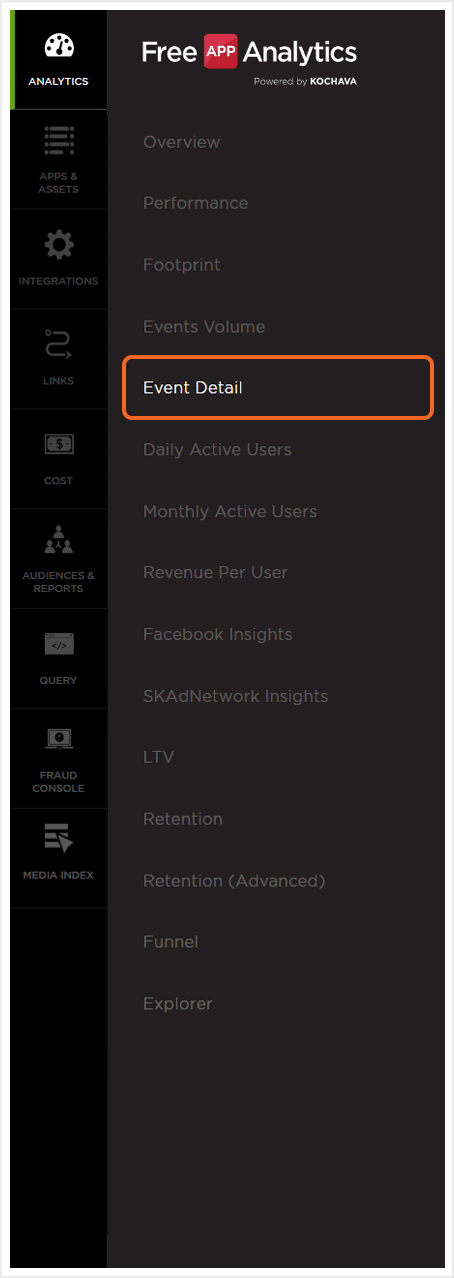
Analytics Page Tools
For more information on the tools available for this Analytic Page such as the date field, exporting device IDs, sharing the page and applying Cohorts and filters, refer to our Analytics Page Tools support documentation.
Event Detail Chart Overview
NOTE: By default no data is displayed with the Event Detail chart is initially opened. An Event must be selected from the provided drop-down menu for data to be displayed.
- Select an Event from the Selected Event drop-down menu.
The Event Detail chart by default displays the Number of Users, Event Count, and any Revenue associated with the selected event. Mousing over any of the days within the chart will display the corresponding data.
NOTE: When leveraging Cross App functionality, the event data that is consistent between each app of the App Name filter will be displayed within the Event Detail. For more information about adding apps using the filter feature, refer to our Analytics Page Tools support documentation.
NOTE: The data displayed for the Number of Users, Event Volume and Revenue may also be turned on or off by clicking on the desired metrics.
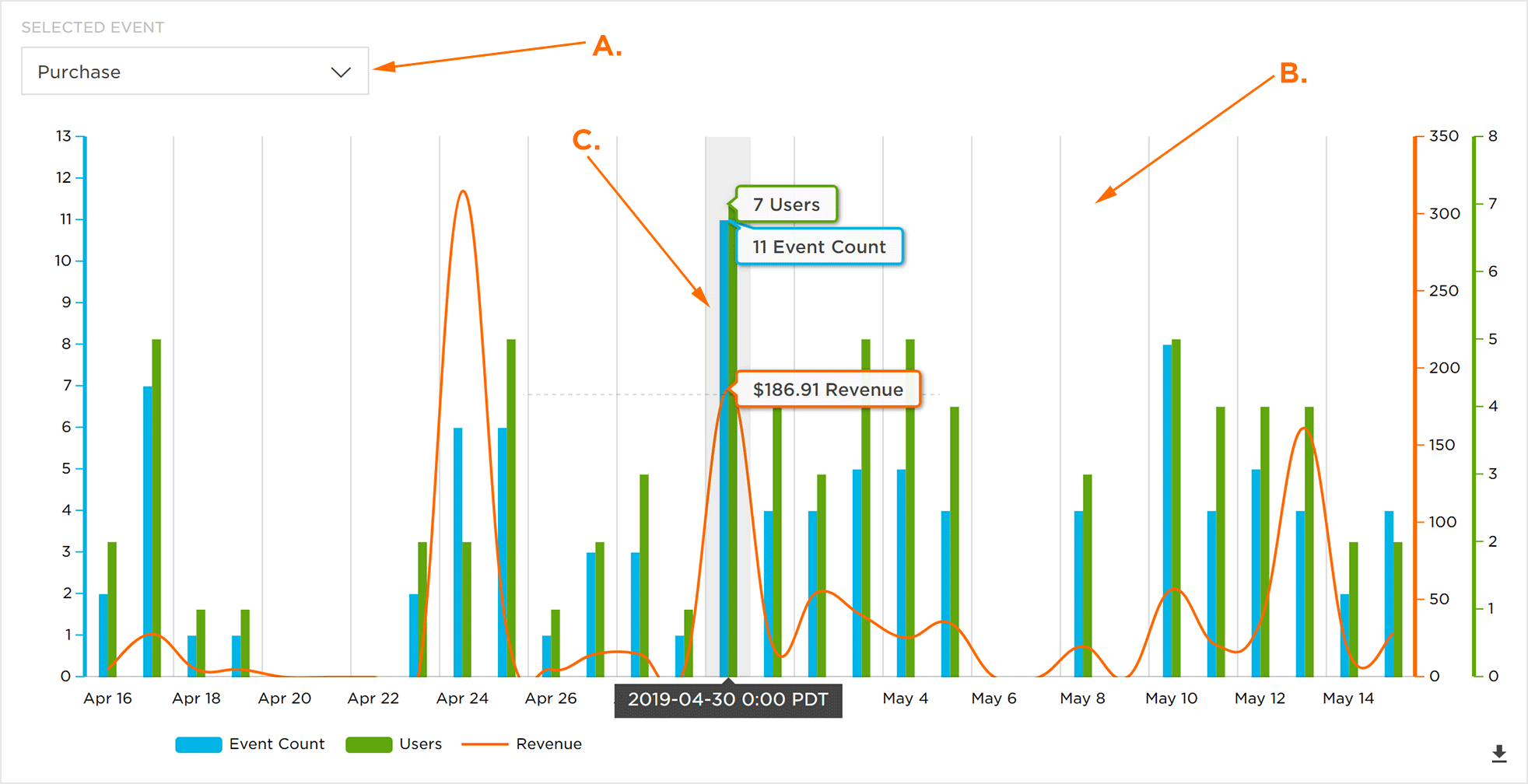
A. Selected Event
B. Graphic display of Event Count, Number of Users and Revenue
C. Mouseover to view data
Downloading Event Detail Data
The data displayed within the Event Detail Chart can be downloaded in several different formats.
Download Graphically:
Select the Download Button > Download Chart Image.
Download Data:
Select the Download Button > Download Data.
Print Data:
Select the Download Button > Print.
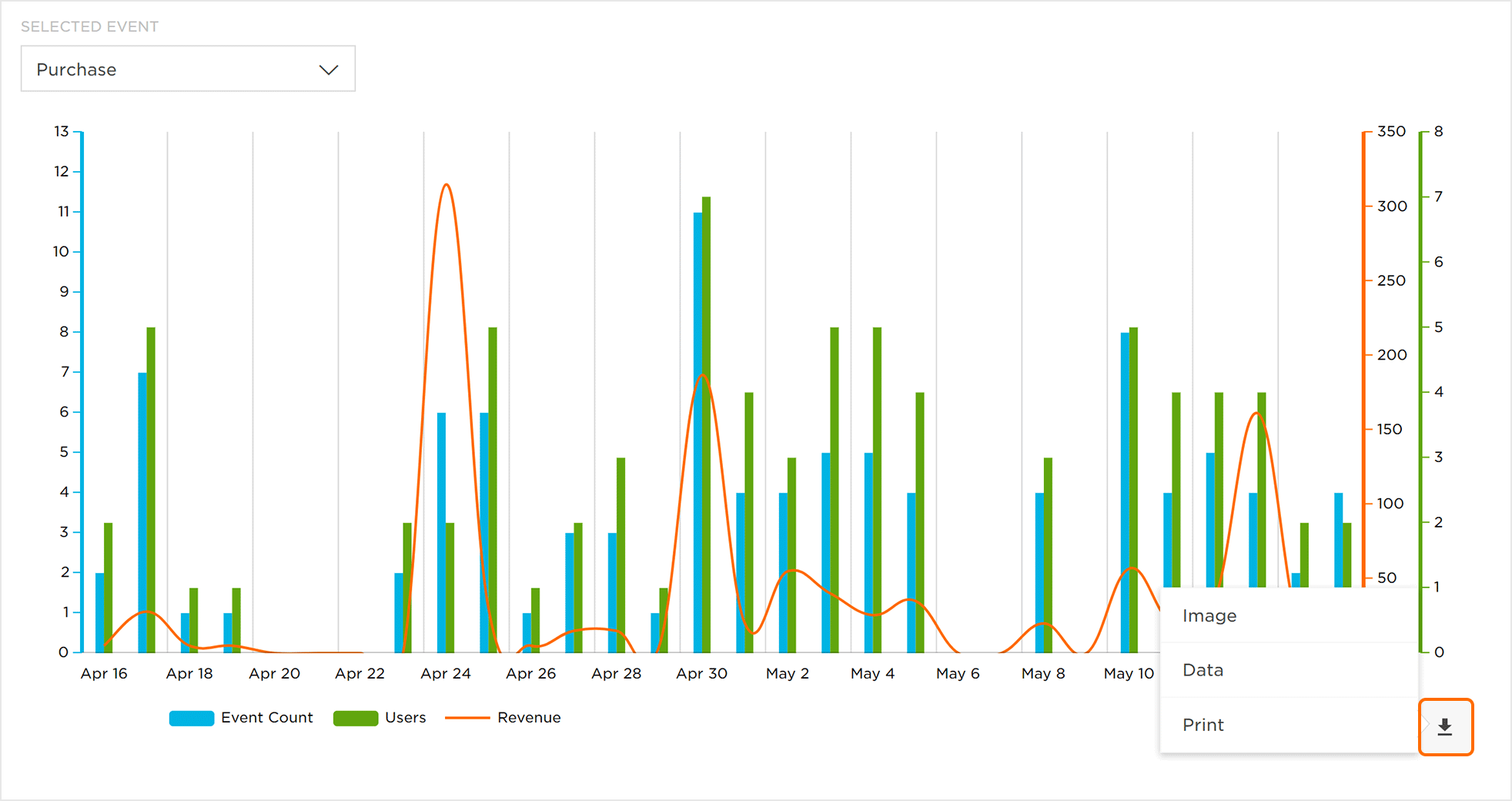
Event Organization
The data displayed for the selected event may be organized in many different ways in order to assist in the optimization of data visualization.
- From the Split By drop-down menu, Select one of the following:
- App
- App IdKochava-specific ID of the app. If selected, data will be organized under each corresponding app ID.
- App NameUser generated name of an app. If selected, data will be organized under each corresponding app name.
- App VersionUnique version name or numeric value that represents the unique state of the app. If selected, data will be organized under each corresponding app version.
NOTE: In order to use the App split by feature, the desired apps must be added utilizing the filter feature. For more information about adding apps using the filter feature, refer to our Analytics Page Tools support documentation.
- Campaign
- CampaignInstall or Post-Install - User generated Campaign Name. If selected, data will be organized under each corresponding campaign name.
- CreativeInstall or Post-Install - Typically an image or video, Kochava receives the creative ID upon install or event. If selected, data will be organized under the corresponding creative ID.
- SegmentInstall or Post-Install - User generated name for a group within a campaign. If selected, data will be organized under each corresponding segment name.
- TrackerInstall or Post-Install - User generated name for a tracker within a segment and campaign. If selected, data will be organized under each corresponding tacker name.
- Device
- Device Carrier NameInstall or Post-Install - The cellular service provider (e.g., Verizon, AT&T). If selected, data will be organized under each corresponding carrier name.
- Device LanguageInstall or Post-Install - The primary language set for the device. If selected, data will be organized under each corresponding language code (e.g., en-US, zh-CN).
- Device Network Conn TypeInstall or Post-Install - The device connection type (e.g., WIFI, Cellular). If selected, data will be organized under each corresponding network connection type.
- Device OrientationInstall or Post-Install - The physical orientation of the device with respect to gravity (e.g, Landscape, Portrait). If selected, data will be organized under each device orientation.
- Device OsInstall or Post-Install - The mobile operating system that is installed on the device (e.g., iOS, Android). If selected, data will be organized under each corresponding operating system.
- Device Os VersionInstall or Post-Install - The unique version number for the operating system (e.g., iOS-10.3.3, Android-8.0.0). If selected, data will be organized under each corresponding operating system version.
- Device TypeInstall or Post-Install - The description of the device that install or post-install event is attributed to (e.g., SM-G935V-Verizon, iPhone8,1). If selected, data will be organized under each corresponding device type.
- Device VersionInstall or Post-Install - The device hardware version (e.g., iPhone-iOS-11.3, Samsung SM-N950U-Android-7.1.1). If selected, data will be organized under each corresponding device version.
- Events
NOTE: The post-install events that are available within this section of the Split By menu are determined by the events setup for tracking. For more information about creating and configuring events, refer to our Post-Install Event Creation and Configuration support documentation.
- Location
- CityInstall or Post-Install - The name of the city where the click, install or post-install event occurred. If selected, data will be organized under each corresponding city.
- CountryInstall or Post-Install - The 2 digit country designation where the click, install or post-install event occurred. If selected, data will be organized under each country.
- DMAInstall or Post-Install - The designated marketing area where the click, install or post-install event occurred. If selected, data will be organized under each corresponding dma.
- RegionInstall or Post-Install - The 2 digit region designation where the click, install or post-install event occurred. If selected, data will be organized under each region.
- ZipInstall or Post-Install - An alpha numeric representation of the particular postal area where the click, install or post-install event occurred. If selected, data will be organized under each corresponding ZIP code.
- Attribution
(see iOS 14+ restrictions)
- TypeInstall - The type of attribution (e.g., Unattributed, Install). If selected, data will be organized under each corresponding attribution type.
- Install CampaignInstall - The install campaigns associated with the app. If selected, data will be organized under each corresponding install campaign.
- Install CreativeInstall - The creative associated with install. If selected, data will be organized under each corresponding install creative.
- Install Matched ByInstall - The device ID type by which the install was matched (e.g., idfa, ip, probabilistic). If selected, data will be organized under each corresponding install match type.
- Install Network NameInstall - The name of the newtork to which the install was attributed. If selected, data will be organized under each corresponding network name.
- Install SiteInstall - The site to which the install was attributed within the publisher partner. If selected, data will be organized under each corresponding site.
- Install TrackerInstall - The tracker name to which the install is attributed. If selected, data will be organized under each corresponding tracker name.
- Matched ToInstall - The identifier to which attribution was matched (e.g., idfa, iad, adid). If selected, data will be organized under each attribution identifier.
- Matched ByInstalls and Post-Install - The method to which attribution was matched (e.g., click, impression, unattributed). If selected, data will be organized under each corresponding attribution method.
- Network NameInstall Post-Install - The name of the network to which attribution was awarded. If selected, data will be organized under each corresponding network name.
- Network IdInstall or Post-Install - The Kochava-specific ID of the network to which attribution was awarded. If selected, data will be organized under each corresponding network ID.
- Network Key
- Partner Ad Group IDInstall or Post-Install - The Kochava-specific ID of the ad group to which attribution was awarded. If selected, data will be organized under each corresponding ad group ID.
- Partner Ad Group NameInstall or Post-Install - The name of the ad group to which attribution was awarded. If selected, data will be organized under each corresponding ad group name.
- Partner Campaign IdInstall or Post-Install - The unique numeric identification for the partner campaign. If selected, data will be organized under each corresponding partner campaign ID.
- Partner Campaign NameInstall or Post-Install - The name of the partner campaign to which attribution was awarded. If selected, data will be organized under each partner campaign name.
- Partner KeywordInstall or Post-Install - The partner keyword for the campaign which was awarded attribution. If selected, data will be organized under each corresponding keyword.
- Partner PlatformInstall Post-Install - The name of the partner digital platform to which attribution was awarded (e.g., facebook, display, messenger). If selected, data will be organized under each corresponding platform.
NOTE: For more information about how the Partner fields map to SAN metadata, please refer to our SAN Networks Campaign Data Mapping support documentation.
- QR CodeInstall - A boolean value (true, false) indicating if the installed was attributed to a QR Code. If selected, data will be organized under the boolean category.
- SiteInstall or Post-Install - The site to which the install or post-install event is attributed to (e.g., 3054, Facebook). If selected, data will be organized under each corresponsind site.
- Agency
- Agency NameInstall or Post-Install - The name of the agency to which the install or post-install event is attributed (e.g., MediaMath, AdParlor). If selected, data will be organized under each corresponding agency name.
- Agency IdInstall or Post-Install - The Kochava-specific agency ID to which the install or post-install event was attributed (e.g., 6702, 8577). If selected, data will be organized under each corresponding agency ID.
- Traffic Verification
- Traffic Verification Fail ReasonInstall or Post-Install - The traffic verifier metric which did not meet the defined condition and value (e.g., country, platform). If selected, data will be organized under each traffic verification fail reason.
- Traffic VerifiedInstall or Post-Install - Inidication whether the traffic has been verified or not. 1 indicates the traffic is verified, 0 indicates it was not verified. If selected, data will be organized under the traffic verified category.
- From the Split Event Volume By drop-down menu, Select an additional filter to split the event volume by. (optional)
NOTE: Up to 50 results will be displayed for the initially selected filter and up to 25 results will be displayed for the secondary filter selected. For a complete list of filtered event data, a report may be generated or the Explorer tool may be used.
- To view the data associated with the secondary metric filter, Click the Filter Expand Button.
NOTE: Mousing over any of the data displayed within the filtered charts will display the specific data associated with the day and event.
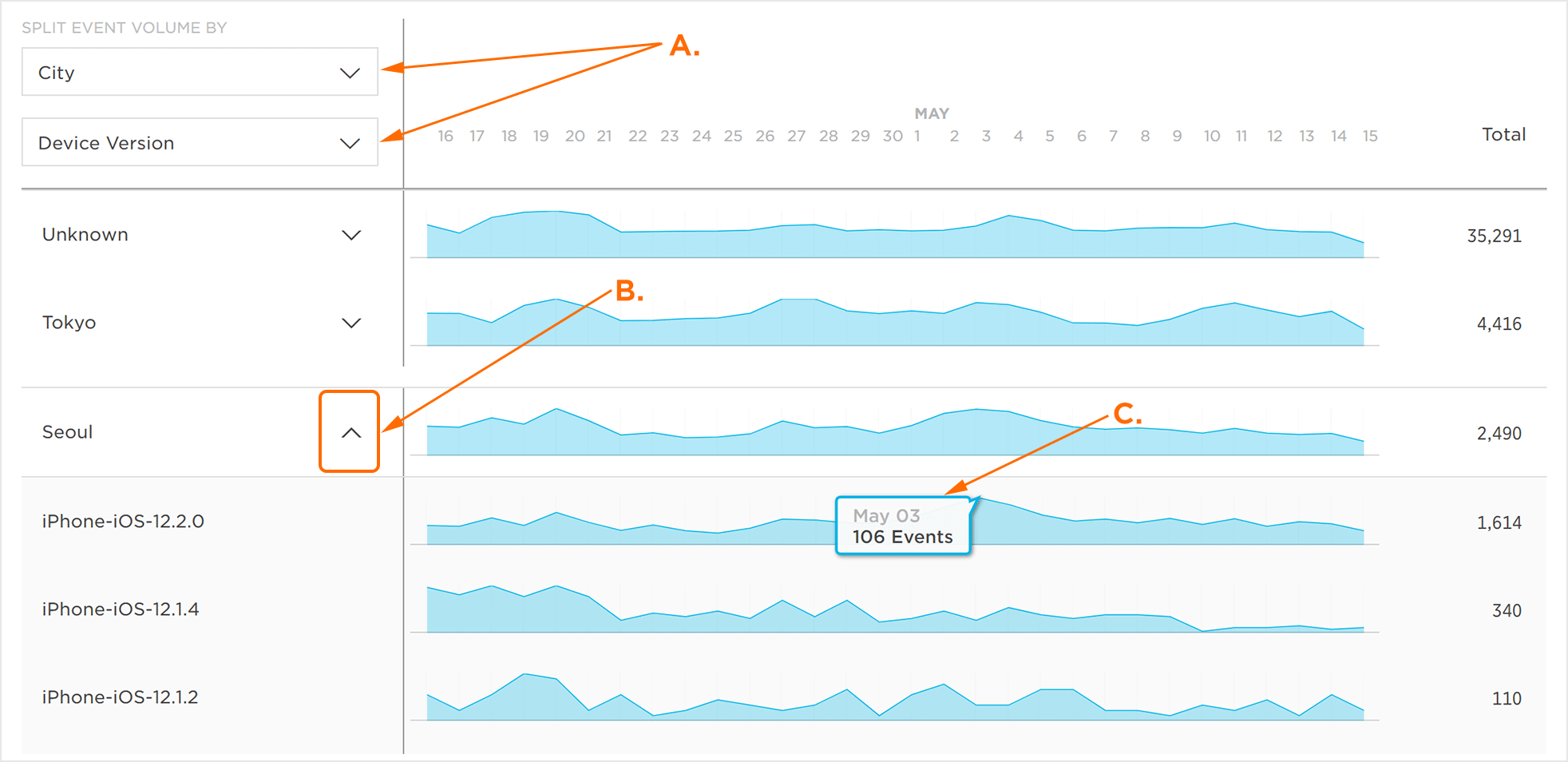
A. Selected Filters
B. Filter Expand Button
C. Mousover chart to display specific data for a specific day
Predicted Churn
FAA Limited Option: This feature is not available within Free App Analytics. Contact us for more information on upgrading to a paid Kochava account.
Churn is the rate at which customers install an app and shortly afterwards abandoned the usage of the app. Churn rate is often used as an indicator of the health of an app’s user base. Kochava has created an algorithm that will score the likelihood to churn within only seven days providing marketers the opportunity to mitigate churn or reengage with their retained users. Our machine learning models observe over 30 data points which can include standard post-install events, custom post-install events tracked by the advertiser, and derived/engineered features.
NOTE: By default, churn modeling is not enabled for an app. If churn modeling needs to be enabled, contact your Client Success Management team.
Churn Score:
The Churn Score is a numeric representation of the probability that the device will churn. The Churn Score is a number that is between 0 and 1, where the closer the score is to 1 the more likely the device is to churn.
Churn Likelihood:
Churn Likelihoods are categories of devices based on the likelihood to churn. The groups represent four ranges of churn scores and are based on a dynamic mid-point that has been optimized for each app/model.
- Low — A group of devices that has a very low risk of churning. On average, these devices will have a churn score between 0 and 0.25.
- Medium Low — A group of devices that have a moderately low risk of churning. On average, these devices typically have a churn score between 0.25 and 0.50.
- Medium High — A group of devices that have a moderately high risk of churning. On average, these devices typically have a churn score between 0.50 and 0.75.
- High — A group of devices that have the highest likelihood of churn. On average, these devices typically have a churn score of 0.75 or higher.
BEST PRACTICES: Kochava recommends that the focus should be on the higher levels of churn. Focus mainly on the High, Medium High and possibly the Medium Low levels of churn.
BEST PRACTICES: Within Analytics Event Detail _PredictedChurn may be selected as the primary event which may be further expanded by splitting the event by Churn Score or Churn Likelihood, as well as the associated Network Name. Filters may also be used to view the event counts for either the Churn Score or Churn Likelihood.
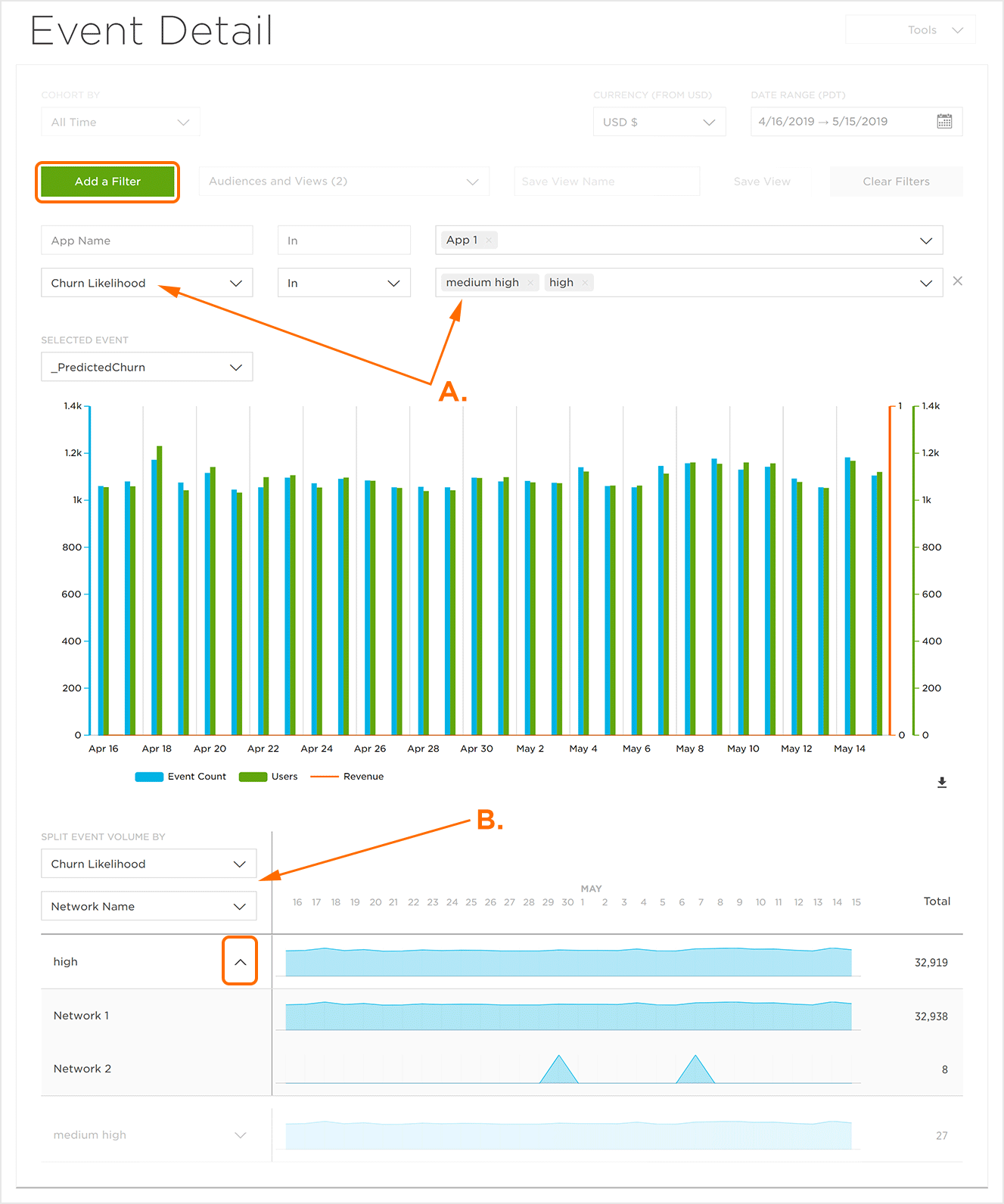
A. Filter added for Churn Likelihood or Score.
B. Event Split by Network for further clarity.





